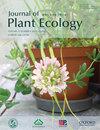寄生互作对网络巢性的丰度效应强于食草互作
IF 3.9
2区 环境科学与生态学
Q2 ECOLOGY
引用次数: 0
摘要
由于物种丰度可能显著影响相互作用频率,因此网络结构对物种多样性和稳定性的重要性应基于偏好网络(由生态位分化组成),而不是观测网络。考虑到食草动物的资源丰度通常大于寄生虫,我们假设寄生虫的丰度效应比食草相互作用更强。为了验证这一假设,我们从已发表的文献中收集了80个定量观察网络,其中包括34个草食性网络和46个寄生网络,并通过去除物种丰度的影响推导出偏好网络。然后,我们使用加权NODF和谱半径来确定网络的嵌套性。我们还确定了观察网络和偏好网络的物种度分布、相互作用均匀性、加权连接度和鲁棒性。观测网络(包括草食和寄生网络)更倾向于用加权NODF而不是谱半径来判断巢性。在加权NODF和谱半径方面,寄生偏好网络比食草网络嵌套得更少,可能是因为去除丰度效应增加了相互作用的均匀性。这些趋势表明,寄生网络的丰度效应强于食草网络的丰度效应。大多数偏好网络的加权连通性和鲁棒性都大于观测网络,表明偏好网络可能比观测网络具有更高的网络稳定性和社区持久性。这些数据表明,未来的网络分析不仅应该解决互惠和拮抗相互作用之间的结构差异,还应该解决食草和寄生相互作用之间的结构差异。本文章由计算机程序翻译,如有差异,请以英文原文为准。
The abundance effect on network nestedness is stronger for parasitic than herbivory interactions
Abstract It has been suggested that the importance of network architecture to species diversity and stability should be based on preference networks (comprised of niche differentiations), rather than observational networks, because species abundance may significantly affect interaction frequencies. Considering that resource abundance is usually greater for herbivores than parasites, we hypothesized that the abundance effect is stronger for parasitic than herbivory interactions. To test this hypothesis, we collected 80 quantitative observational networks including 34 herbivorous and 46 parasitic networks from the published literature, and derived preference networks by removing the effects of species abundance. We then determined the network nestedness using both weighted NODF and spectral radius. We also determined species degree distribution, interaction evenness, weighted connectance and robustness for both observational and preference networks. The observational networks (including both herbivory and parasitic networks) were more nested judged by weighted NODF than spectral radius. Preference networks were less nested for parasitic than herbivory networks in terms of both weighted NODF and spectral radius, possibly because removing the abundance effect increased interaction evenness. These trends indicated that the abundance effect on network nestedness was stronger for parasitic than herbivory networks.Weighted connectance and robustness were greater in most preference networks than observational networks, indicating that preference networks may have higher network stability and community persistence compared to observational ones. The data indicate that future network analyses should not only address the structural difference between mutualistic and antagonistic interactions, but also between herbivory and parasitic interactions.
求助全文
通过发布文献求助,成功后即可免费获取论文全文。
去求助
来源期刊

Journal of Plant Ecology
生物-植物科学
CiteScore
4.60
自引率
18.50%
发文量
134
审稿时长
3 months
期刊介绍:
Journal of Plant Ecology (JPE) serves as an important medium for ecologists to present research findings and discuss challenging issues in the broad field of plants and their interactions with biotic and abiotic environment. The JPE will cover all aspects of plant ecology, including plant ecophysiology, population ecology, community ecology, ecosystem ecology and landscape ecology as well as conservation ecology, evolutionary ecology, and theoretical ecology.
 求助内容:
求助内容: 应助结果提醒方式:
应助结果提醒方式:


